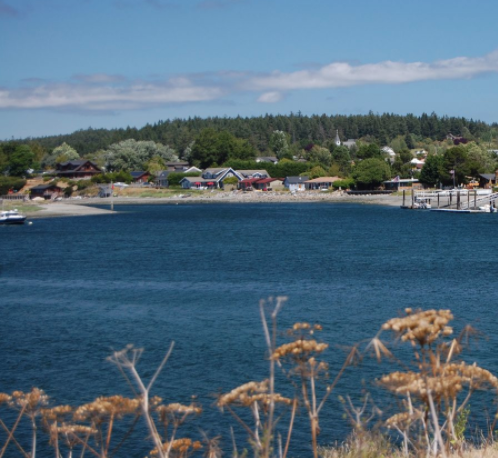||| FROM SALISH-CURRENT |||
Over the last 50 years, San Juan County has grown from a year-round population of 3,856 to 18,040 and has attracted a growing number of seasonal visitors and part-time residents.

Lopez Island aquifers logged some of the highest recharge rates in the county when water supply was last studied. A new study next year will provide important data for managing supply as well as planning for the future as the population continues to grow. (Amy Nelson photo © 2021)
As the population has grown, water usage also has increased, at times overwhelming capacity in some systems. Summer drought conditions in recent years have necessitated rationing in some larger water systems, while some wells go dry for a period each summer. (Read more: “San Juan Islands’ fresh-water supply sustainability is in question,” Salish Current, Jan. 7, 2020.)
A study funded by the state legislature and the U.S. Geological Survey (USGS) will address a major barrier in both predicting San Juan County’s future water needs and managing current systems: the capacity of wells in the county is unknown.
Last year, the legislature appropriated $92,000 for the county’s public health department to contract with USGS to update the most recent study. That survey was completed in 2002, when the county’s year-round population stood at 14,077, and was based on field work done in 1997 and 1998.
“The total cost of the [new] study for San Juan County is $150,000, with USGS providing a share of $58,000,” said environmental health specialist Ethan Schmidt.
The county has had some extra time to anticipate the work, Schmidt suggested: “We actually were supposed to start the program this year, but COVID delayed it.”
Dependent on rain
The study has three main focal points, Schmidt explained.
First, geologists will evaluate ground and surface water, as well as meteorological data, primarily evaporation and precipitation.
Next, they will analyze how long it takes aquafers to recharge, as done in the 2002 study.
“Aquifer recharge refers to the amount of surface water that actually percolates downward and becomes groundwater, available to be drawn up by a water well,” Kyle Dodd, San Juan County environmental health manager, said.
The island county’s aquifers are entirely rain-replenished. While the quantity of water coming into the island systems is both limited and not fully measured, what is known is that not more than 10% of total precipitation is absorbed into water systems, Dodd said. (Read more: “Water concerns spark funding request for groundwater studies for San Juans, Guemes,” Salish Current, Jan. 21, 2020.)
Different rock, different recharge
The 2002 study estimated groundwater recharge from precipitation in glacial-deposit (crushed and mixed rock fragments) and fractured-bedrock aquifers in selected areas of the county.
The report focused on Lopez, Shaw, Orcas and San Juan islands, the largest and most populated of the archipelago, and described how soil types, temperature, amount of precipitation, water evaporation and run-off affect aquifer recharge. It noted that determining the rate of aquifer recharge from precipitation is key to determining groundwater availability.
Weather, soil conditions and vegetation were assessed on a daily basis to estimate groundwater recharge over larger areas.The study also measured atmospheric chloride deposition, precipitation, stream flow and groundwater chloride concentrations in specific areas.
A 1997 U.S. Geological Survey report on Lopez Island notes that the United States Environmental Protection Agency advises that water with high chloride content — one effect of rising sea levels and saltwater intrusion into aquifers — may cause high blood pressure, taste salty and corrode or discolor pipes and appliances, among other effects.
Among the four islands, the 2002 study found that Lopez has some of the highest recharge rates — from 3 to 9 inches annually in various areas — due to a large area of glacial deposits covering bedrock. In contrast, Shaw has some of the lowest recharge rates, at about an inch or less annually.
READ FULL ARTICLE: salish-current.org/2021/07/21/have-enough-water-san-juan-prepares-to-find-out-with-usgs-study/
**If you are reading theOrcasonian for free, thank your fellow islanders. If you would like to support theOrcasonian CLICK HERE to set your modestly-priced, voluntary subscription. Otherwise, no worries; we’re happy to share with you.**








This is good news. Water may be the most important baseline factor in planning for future population and sustainability during rapidly changing climate conditions.
This study is happening due to the efforts of a number of locals. Anne Marie Shanks and Sheila Gaquin first communicated the idea of a water capacity study to Senator Liz Lovelett two years ago, and it was all set to be funded when Covid hit. At that point the governor made lots of cuts, including this water study. Joe Symons has been leading an effort for some 30 years to find out what our actual human capacity is here in the islands, and his presentation to the local Democrats in January reactivated this idea. With the cooperation of Ethan Schmidt at the county office and Senator Lovelett’s office, the study was again approved by the Legislature this year and is set to begin. Thanks to Heather Spaulding for writing this informative article. Thanks to all involved for making this important analysis a reality.